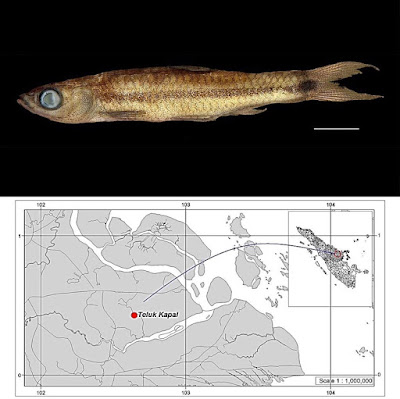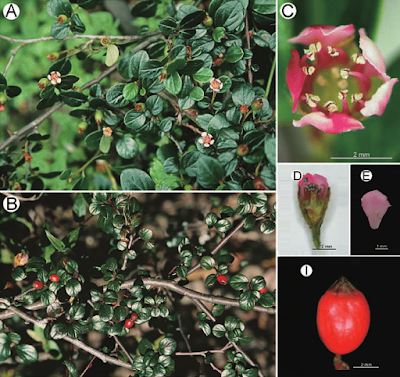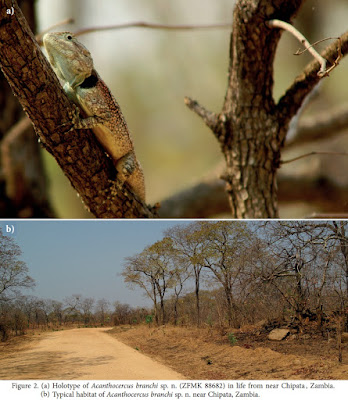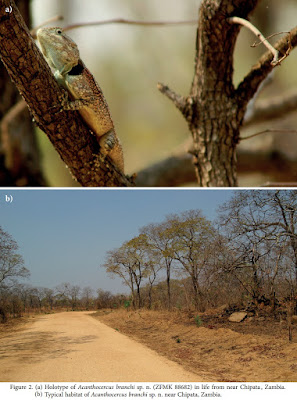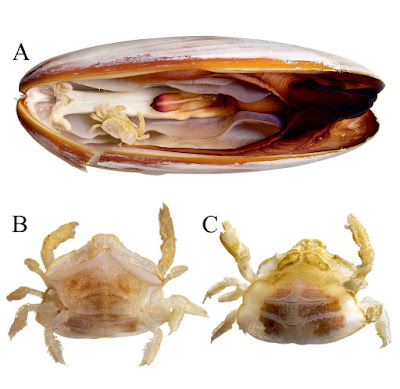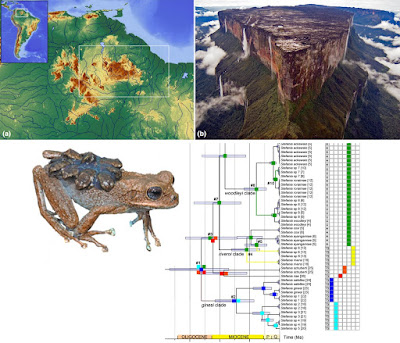[Most Recent Entries] [Calendar View]
Wednesday, October 12th, 2016
| Time | Event | ||||
| 12:00a | [Ichthyology • 2016] Pectenocypris nigra • A New Danionine Species (Cyprinidae: Danioninae) from Sumatra (Indonesia)
A new species of Danioninae, Pectenocypris nigra nov. sp. is described from peat swamps in the Riau Province, central Sumatra (Indonesia). The species differs from its congeners in the combination of the following characters: a distinct mid-lateral stripe, black spot on the base of the caudal fin, scales pale fawn with blackish margin; 28-30 scales in lateral midline, 7-10 pored lateral line scales, 160 gill-rakers on the first gill arch, and a short and deep caudal peduncle. Keywords: Pectenocypris, Taxonomy, Morphology, Endemic, Indonesia. A. Wibowo, H. Ahnelt and E.S. Kertamihardja. 2016. Pectenocypris nigra, A New Danionine Species (Teleostei: Cyprinidae: Danioninae) from Sumatra (Indonesia). Acta Biologica Turcica. 29(4); 137-142. | ||||
| 12:34a | [Botany • 2011] Cotoneaster rosiflorus • A New Species (Rosaceae) from Taiwan
Abstract A new species of Rosaceae subfam. Spiraeoideae, tribe Pyreae (formerly subfamily Maloideae) from Taiwan is described. A taxonomic treatment, line drawings, color photographs and pollen SEM micrographs are provided to illustrate the species. A somatic chromosome number of 2n = 68 is reported for the first time for Cotoneaster rosiflorus. Cotoneaster rosiflorus occurs mainly at 2,500-3,500 m altitude in central Taiwan. It resembles C. morrisonensis vegetatively, but is distinct by the erect to slightly spreading pink petals, pink or reddish filaments, 3-5 styles, and 3-5 pyrenes. K.-C. Chang, C.-C. Wang, S.-L. Deng, Yoshiko Kono, F.-L. Lu and Ching-I Peng. 2011. Cotoneaster rosiflorus (Rosaceae), A New Species from Taiwan. Botanical Studies. 52(2); 211-218. | ||||
| 4:03a | [Herpetology • 2012] Acanthocercus branchi • A New Species of the Acanthocercus atricollis complex (Squamata: Agamidae) from Zambia
Abstract In the course of working on a taxonomic revision of the Acanthocercus atricollis complex, we discovered a population from the Luangwa and Zambezi valleys in Zambia and adjacent Malawi that is morphologically and genetically distinct from all described taxa of this complex. This population is described as a new species on the basis of morphological characters, including indistinct transverse rows of enlarged scales on the body, a large black patch on the shoulders, and a different pholidosis. It is morphologically similar to A. a. gregorii and A. a. loveridgei, but seems to be more closely related to the former. Key words. Squamata, Agamidae, Acanthocercus atricollis, new species, Africa, Zambia, Malawi, Zambezi Valley, Luangwa Valley.
Distribution: The new species is known from localities within the Luangwa (Chipata, Chikowa, Sayiri Court) and Zambezi (Lusaka) valleys in Zambia. Habitat and ecology: This new species is a tree dweller as it is typical for the A. atricollis complex (Reaney & Whiting 2003), although not for all subspecies (Wagner unpubl. data). In Chipata, it was collected in dense Miombo woodland with large trees and a structured canopy. In Lusaka, it was captured on a solitary tree. At both localities, other individuals were also observed, but it was not possible to identify them as males or females. Specimens from Pioneer Camp were observed while climbing on tree trunks. Etymology: This new species is named in honour of our friend and colleague William Roy Branch, in recognition of his important contributions to our knowledge of African amphibians and reptiles over several decades, and in commemoration of his nominal retirement as curator of herpetology at the Port Elizabeth Museum (Bayworld). Philipp Wagner, Eli Greenbaum and Aaron Bauer. 2012. A New Species of the Acanthocercus atricollis complex (Squamata: Agamidae) from Zambia. SALAMANDRA. 48(1); 21–30. | ||||
| 7:49a | [Crustacea • 2016] Serenotheres janus • A New Species of Pea Crab of the Genus Serenotheres Ahyong & Ng, 2005 (Brachyura, Pinnotheridae) from the Date Mussel Leiosolenus Carpenter, 1857 (Mollusca, Bivalvia, Mytilidae, Lithophaginae) from the Solomon Isla
Abstract The pea crab genus Serenotheres Ahyong & Ng, 2005 (Pinnotheridae) is currently only represented by one species, S. besutensis (Serène, 1967). A new species is now assigned to this genus, described from a date mussel Leiosolenus obesus Carpenter, 1857 (Mollusca: Bivalvia: Mytilidae: Lithophaginae) collected in the Solomon Islands. Serenotheres janus sp. n. differs from S. besutensis in possessing a conspicuously broader carapace, with the lateral margins of the dorsal lamellum distinctly produced and the posterolateral part deeply concave, the dorsal lamellum being highest at the median cleft, the rostrum is relatively more prominent, the surfaces of the anterolateral margin and hepatic region are less prominently pitted and eroded, the ischiomerus of the third maxilliped is relatively more rectangular, and the P2 merus is proportionately longer. Keywords: Pinnotheridae, taxonomy, symbiotic crab, new species, symbiotic crab, Serenotheres janus, Solomon Islands
Systematics Family Pinnotheridae De Haan, 1833 Genus Serenotheres Ahyong & Ng, 2005 Serenotheres janus sp. n. http://zoobank.org/FD849337-EB57-46F6-96 Type material: Holotype ♀ (8.9 × 7.9 mm) (USNM 1421642), in Leiosolenus obesus (Philippi, 1847) (Mollusca: Bivalvia: Mytilidae: Lithophaginae), from Njari Island, New Georgia, Solomon Islands, station SOLOM_026; 8.01374°S, 156.75649°E, coll. C. Meyer, 9 October, 2014. Diagnosis: Carapace distinctly pentagonal; lateral margins of dorsal carapace lamellum distinctly produced with posterolateral part deeply concave, highest at median cleft with 2 halves sloping gently outwards in direct frontal view; rostrum distinct with surface above antennular fossa prominently concave; surfaces of anterolateral margin and hepatic region less prominently pitted, eroded; MXP3 ischiomerus relatively more rectangular; P2 merus relatively long. Etymology: The species is named after Janus, the ancient two-faced Roman god, alluding to the unusual two parts of the carapace when viewed dorsally. The name is used as a noun in apposition. Peter K. L. Ng and Christoph Meyer. 2016. A New Species of Pea Crab of the Genus Serenotheres Ahyong & Ng, 2005 (Crustacea, Brachyura, Pinnotheridae) from the Date Mussel Leiosolenus Carpenter, 1857 (Mollusca, Bivalvia, Mytilidae, Lithophaginae) from the Solomon Islands. ZooKeys. 623: 31-41. DOI: 10.3897/zookeys.623.10272 | ||||
| 8:31a | [Herpetology • 2016] Evolution in the South American ‘Lost World’: Insights from Multilocus Phylogeography of Stefanias (Anura, Hemiphractidae, Stefania)
Abstract Aim To investigate the influence of tepuian geomorphology on species diversification in the Pantepui biogeographical region based on the phylogenetic relationships and divergence times of tepui-endemic clades of stefania frogs (Stefania, Hemiphractidae). Location The ‘tepuis’ and uplands/lowlands of the Pantepui biogeographical region of northern South America, one of the least accessible and least studied areas in the world. Methods Two mitochondrial and two nuclear DNA sequences from 60 individuals of Stefania from 24 localities in Pantepui were employed to infer phylogenetic affinities and estimate divergence times within the genus using both concatenation and species tree analyses. Ancestral areas were inferred using multiple models in a common likelihood framework. Results Phylogenetic analyses revealed high diversity in the genus Stefania with 10 candidate species in the Eastern Pantepui District. Four strongly supported clades are recovered in the area, one being exclusively composed of microendemics on isolated tepui summits. Biogeographical analyses suggest episodes of fragmentation of widespread tepuian ancestors from the onset of diversification of the genus, estimated in the Oligocene (c. 26 Ma), therefore suggesting a neglected vicariant model of Pantepui evolution, the Plateau Theory. Main conclusions Although our results suggest that vicariance played an important role in the diversification of Stefania, speciation in Pantepui followed an intricate pattern implying multiple nonexclusive processes. Vicariance and dispersal likely influenced diversification patterns of the Pantepui fauna, possibly according to the following sequence: (1) Cenozoic vicariance; (2) reorganization of species diversity due to periods of climatic instability; (3) recent invasions (Pleistocene) of widespread upland taxa. Keywords: ancestral areas, anuran, dispersal, divergence times, frog, molecular phylogenetics, phylogeography, tepui, Venezuela, vicariance Philippe J. R. Kok, Valerio G. Russo, Sebastian Ratz, D. Bruce Means, Ross D. MacCulloch, Amy Lathrop, Fabien Aubret and Franky Bossuyt. 2016. Evolution in the South American ‘Lost World’: Insights from Multilocus Phylogeography of Stefanias (Anura, Hemiphractidae, Stefania). Journal of Biogeography. DOI: 10.1111/jbi.12860 |
| << Previous Day |
2016/10/12 [Calendar] |
Next Day >> |
